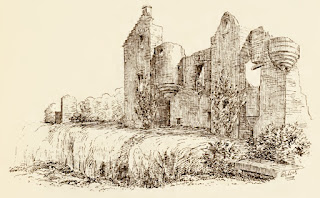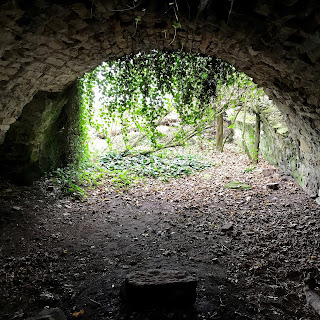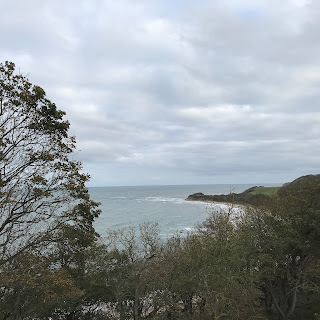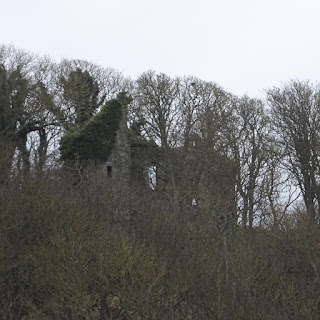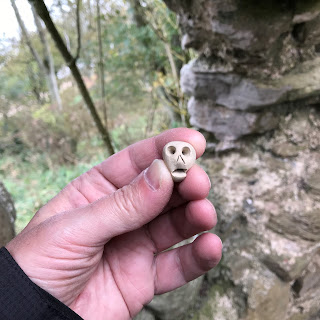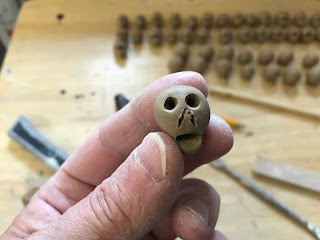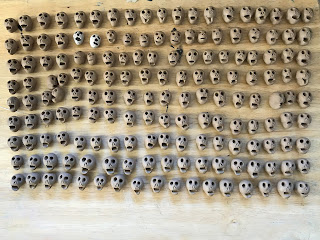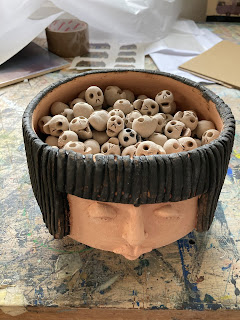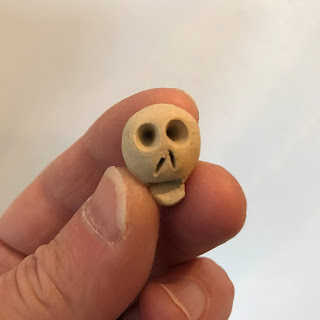I arrive at
North Berwick Railway Station at around lunchtime and walk out of the town and
along the coast road. The waters of the
Forth are grey and choppy and the Bass Rock is still white with the thousands
of gannets who came to nest on it during the summer. They will soon fly off to the warmer climes
of Morocco. As the cold wind from the
sea cuts through me I think that one day it would be nice to follow them for a
bit of winter warmth.
The pavement
along the road soon ends and I walk along the grass verge and past Tantallon
Castle. An imposing ruin perched on the
cliffs above the sea. About a mile
further on I come to the road that leads down to Seacliff and the beach
there. I follow this down for a little
while and then turn off into a muddy path through the woods. Through the nettles and dying back stalks of
plants unknown I walk to the dark and overgrown ruins of Auldhame Castle.
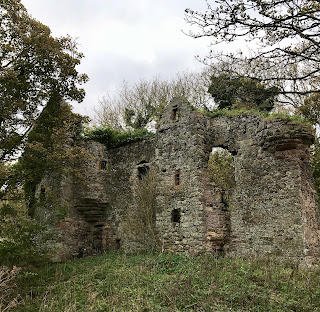
The sea facing wall of Auldhame Castle
Castle doorway
The castle
sits on the cliffs that overlook Seacliff beach, in an area where one of the
three corpses of Saint Baldred of Tyninghame is said to be buried. Saint Baldred was a Northumbrian monk who is
believed to have founded an abbey at Tyninghame. He also had a small hermitage on the Bass
Rock, though sometimes lived in a cave on Seacliff beach. After his death there was a disagreement
between three of the parishes, he had close association with, as to who should
get his body. Holy men from each parish
spent the night together in prayer and the next morning there were three bodies
of Saint Baldred lying there - one for each parish. So, everyone went home happy with a body to
bury.
Auldhame Castle was built in the early 16th century for Sir Adam
Otterburn (1491-1548). He was a lawyer and a diplomat who served the Scottish
Monarchy. He was the Kings Advocate to
James V of Scotland and Secretary to Mary of Guise. He also served as the Provost of Edinburgh. In 1534, on behalf of King James V of Scotland,
he went to London and signed a border peace treaty between Scotland and
England. In 1536, he was again sent to
London after Henry VIII had requested a meeting with James V. There he discussed the motives for the
meeting and also what the agenda would be.
In 1538 he wrote a speech to welcome Mary of Guise to Edinburgh, who had
recently married James V. Otterburn then
had a bit of a falling out with James and spent some time in prison before
being deprived of his office and fined £1000.
When James died in 1542, the Earl of Arran took over as Regent and politics
in Scotland heated up somewhat with various factions and rivalries forming. Henry VIII of
England made an agreement with the Earl of Arran that the daughter of James,
the infant Queen Mary of Scots, should marry his son, Prince Edward. Some in
Scotland favoured the marriage while others preferred to keep their
alliance with France. Mary of Guise persuaded
the Earl of Arran that the agreement should be reneged, and this then led to an
English invasion, which was given the name the Rough Wooing. In 1544, the English army landed at Granton
and Otterburn was sent to negotiate with them.
However, they refused to negotiate and burned the town of Leith and
parts of Edinburgh. In 1547, Otterburn
travelled to Hampton Court to negotiate with the then King of England, Edward VI,
to try and avoid the conflict between the two countries resuming. Again, his negotiations failed, though he was
sent away with a gift of £75 for his efforts.
He then wrote to the Earl of Arran telling him about the preparations he
had seen the English army making and how ready and prepared they were for
war. The earl of Arran ignored his warnings,
and the Scottish army was defeated at the Battle of Pinkie later that year. In 1548, Otterburn died after being assaulted
in Edinburgh by the Laird of Annestoun, Patrick Mure, who was a servant of the Earl
of Arran. Mure and his son were charged
with treason and murder, but it is unclear what happened to them and if any
further proceedings took place.
Auldhame
Castle was originally an L plan tower house.
The main building consisted of three storeys with a projecting stair
tower.
The ruins of Auldhame Castle circa 1892
There is not
much left of the building now, just the outer wall that faces to the sea and
part of the vaulted basement. In the
basement someone has built a barbecue with old stone and a wire shopping
basket. It looks quite new and is maybe
someone’s Covid hidey-hole. It is
sheltered from the wind and with a fire going it would be quite a comfortable
drinking den.
Castle basement
Outside,
against the inside of the outer wall, a tree has fallen, and I scramble up this
to a ledge by one of the second storey windows.
The view from this must have been pretty spectacular back in the day but
is now blocked by dense woodland. Below
me I can hear the waves crashing on the beach and children shouting. Around me crows caw and pigeons coo and small
creatures scrabble around in the undergrowth.
View from the clifftop by Auldhame Castle
View of Auldhame Castle from Seacliff
Near to the
window, there is a narrow opening in the wall.
I place a Skulferatu there and scramble back down.
Skulferatu #2
Skulferatu placed in hole in the wall
Google Map showing location of Skulferatu
The
coordinates for the location of the Skulferatu are –
Latitude 56.053061
Longitude
-2.639833
I used the following sources for
information on Auldhame Castle –
Castles Today
History of Auldhame
Castle
Wikipedia
Adam Otterburn
Auldhame Castle
The Castles of Scotland
Auldhame
| Seacliff | The Castles of Scotland
Sketch of Auldhame Castle from -
The Castellated and Domestic Architecture of
Scotland from the Twelfth to the Eighteenth Century
Volume Four
By David MacGibbon and Thomas Ross
1892








